A lot of times, even after submitting your application you will be stuck waiting for a response from the hiring team. This is totally normal as employers have a large number of applications they need to review, so it can take some time!
In fact, according to one survey, up to half of all applicants never hear back from their potential employer.
That’s why it is important to remain active with interviews and follow up calls/emails until you get a positive reply. But how do you know if you are being overlooked or if there is just really no chance that you would get hired?
There are several things employers look at when deciding whether to invite you in for an interview. The applicant tracking system (ATS) used by most companies collects this information and puts it into documents and notes. These include things such as:
– Are you responding quickly to messages?
– Do you seem interested in our company and position?
– Does it appear that you have done your research about the job and company
– Have you asked us questions showing that you care about the work and this organization
These days, almost every big company uses an applicant tracking system (or ATS). As mentioned before, these systems collect all of this information and organize it into documents and notes. So, what people usually do is log onto the ATS tool and look through those documents and notes to see if they can find anything about you.
Practice interviewing skills

Along with your resume, there will be an interview process for every position you apply for. This is particularly true now with most companies using some sort of application or interactive questionnaire to evaluate potential employees.
Most employers have automated software that they use to conduct interviews. These applications usually create a space where applicants can answer questions and then automatically collate all of their answers into a database. Companies use this data to match candidates and determine who would be a good fit.
Interviews are very important parts of the employment process as they assess whether you could do the job and if you’re a good cultural fit. Therefore, it is extremely important to prepare for yours!
Practice talking about yourself and answering questions under different circumstances. If possible, try doing a mock interview so you know what to expect.
Create engaging videos

A well-designed application process will have very little emphasis on interviews, as most employers now use applicant tracking systems (ATSs) that gather all of your personal information before inviting you in for an interview.
This is not necessarily a bad thing! Companies tend to invest in robust security features because they want to make sure that their ATS is protected against malicious actors who may be trying to access sensitive data or hire someone else under false pretenses.
By investing in these protections, you’ll help ensure that your personal details are hard to steal even if someone does manage to get past the front door.
But this means that many companies now ask job applicants to submit applications via online ATS platforms where anyone can watch the process unfold. This can sometimes seem like a daunting situation for professionals who value their privacy and confidentiality.
Fortunately, there are ways to mitigate some of these challenges. One easy way to do so is by creating engaging video messages that emphasize your strengths and speak to why you would be a good fit for the company.
Update your LinkedIn profile

A lot of employers look at LinkedIn as an easy way to check out someone’s job history. Therefore, it is important to make sure that your profile is consistent with who you are as a person and what you want to convey about yourself.
If there's something in your profile that you don't like or can't stand, then get rid of it! Refrain from changing things around unless you have done so before, and most importantly, be honest.
Your profile is a place for potential employers to learn more about you, so keep it levelheaded and focused on giving solid answers to questions they may ask.
Use job boards such as Craigslist, Monster, and CareerBuilder

By using these sites, you can search for your favorite companies or positions, then determine if any open applications have been posted. If there are none, you can still apply!
Craigslist is one of the most popular ways to find jobs. This site allows you to create your own profile, and then you can either list or browse through other people’s profiles. The way it works is, whoever creates an ad gets to set their price per listing, so make sure to research cost-effective options.
By being aware of your budget, you will know whether to list yours free or paid. If you are in a very competitive area, thinking about investing money into your career may be warranted, but not if there are no openings at all.
Monster and CareerBuilder both offer applicant tracking systems (ATS) that work similarly to what we talked about with the phone screen. These ATSs keep track of who has applied for what position, how many times they logged in to view the position, and if they included enough information in their application. All this info is saved automatically in the system, so there isn’t much someone else would need to input beyond confirming their identity and answering questions put forward by the company.
Find out what the company is looking for

The more you know about a company, the better your chance of getting employed by them! If there are any social media accounts or forums with their products or services, research those to get some insights into who they are as people.
Interviews are a great way to learn more about a company and their culture. Even if you are not necessarily applying for a position within the company, it’s still worth doing because this will give you some insight into how they like to be organized and paid-for in terms of time.
If possible, try speaking to someone in the same department as the job posting you have applied for so that you can get an idea of whether or not they’re really needed there.
Application interviews should also go through at least half a day since most employers take longer than expected to make up their mind about candidates – this can sometimes drag on for hours. Make sure you don’t become distracted or nervous since it could affect your performance.
Be prepared for the interview by reading the posted job description, talking to colleagues in the area, finding out as much information as you can online and brainstorming potential questions.
Come prepared

While most ATSs are web-based, that doesn’t mean you can just go in any old way and try to apply. Some require you to take a specific online test and some even ask for more information that cannot be submitted until you have logged into your account!
By being ready ahead of time, you will not be stressed or overwhelmed when you do get through the initial screening process. Also, knowing what resources there are available to help you out makes it easier to focus only on applying, not looking up tutorials or tips.
Something else to consider is whether this really is the right job position for you. If you feel that you don’t belong at this company, don’t waste anyone’s time trying to prove yourself. You would also want to make sure your personal life wouldn’t affect your work performance.
Good luck getting past the ATS, but remember, if you're not feeling confident or need extra guidance, check out help pages online.
